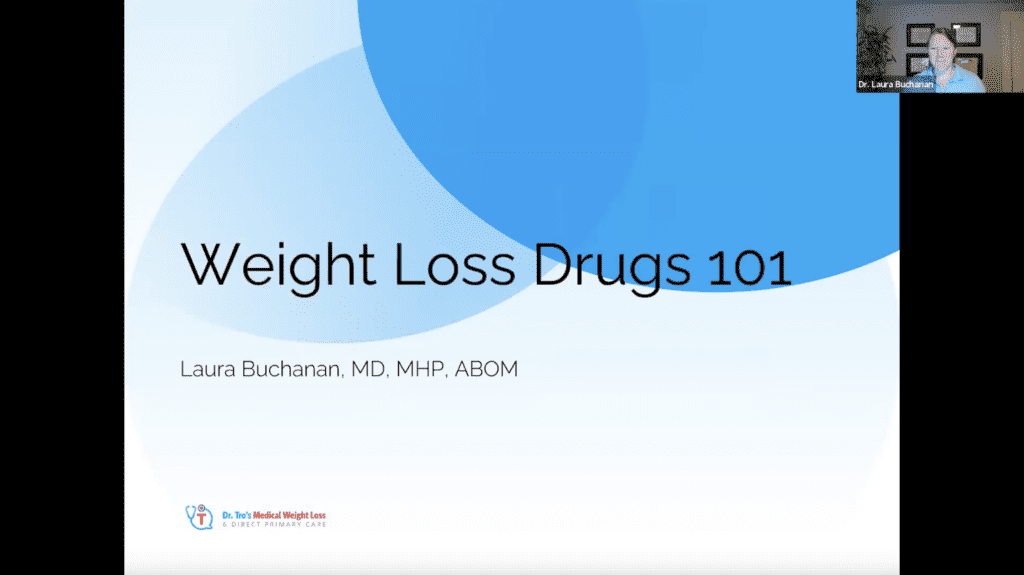What is all the hype about using Semaglutide/Liraglutide (Wegovy/Saxenda) for weight loss?
You have probably heard of Wegovy or Saxenda. These are the two GLP-1 agonists that are approved for weight loss. Their full generic and brand names with dosing are: Semaglutide 2.4mg once weekly (Wegovy) and liraglutide 3mg once daily (Saxenda).
#1 How do these medications work?
First, let’s start our discussion with what happens in your body without any medications. Your body naturally releases hormones called incretins from your gut into your bloodstream after eating a meal. These hormones increase your body’s release of insulin, among other things. Two important incretins are Glucagon-Like Peptide-1 (GLP-1) and Glucose-Dependent Insulinotropic polypeptide (GIP). GLP-1 and GIP are responsible for up to 70% of your insulin response to a meal! GLP-1 receptors are found throughout the body, including in the brain. Their functions include:
- Stimulating insulin secretion
- Decreasing glucagon release, thus decreasing production of glucose from the liver
- Increasing satiety
- Decreasing appetite and hunger
- Delaying gastric emptying
- Decreasing pancreatic beta-cell death and promoting healthy growth
- Altering food preference and reward pathways, including lowering the desire for energy-dense foods and decreasing cravings
So how do GLP-1 agonists work to help aid weight loss?
People with obesity have lower levels of GLP-1, which makes it harder to shut off their glucose production and increases feelings of hunger. Agonists like semaglutide are akin to hormone replacement therapy in postmenopausal women. Just as hot flashes and other menopause symptoms can be improved by taking estrogen, so too can symptoms like excessive hunger – caused by GLP-1 deficits – be treated with a GLP-1 agonist.
When people lose weight, their bodies start producing fewer satiety hormones, specifically leptin and peptide YY (PYY for short). The net effect can be that the more weight you lose the hungrier you get. GLP-1 agonists seem to prevent some of the decline in leptin and can also increase PYY levels.
Unfortunately, just like with estrogen, symptoms may return if someone stops taking the medication.
Also worth noting, nausea is one of the main side effects of GLP-1 agonists, and some people think this contributes to weight loss. However, studies show that weight loss takes place after controlling for side-effects (more details on this below).
#2 What do the major studies show?
There are four major trials that studied semaglutide, called Step 1 through 4 respectively. The Step 2 trial was focused on diabetes rather than weight loss, so we’re only going to discuss Step 1, 3 and 4 in this post.
STEP 1 used 2.4mg of once weekly semaglutide in 1,961 individuals with a [BMI >30] or [BMI >27 with another medical condition]. They found an average 14.9% (15.3kg or 33.7 lbs) weight loss after 68 weeks in the semaglutide group vs. 2.4% (2.6kg or 5.7 lbs) in the placebo group. 32% of participants lost more than 20% of their weight. Nausea and diarrhea were the most common side effects and were typically mild-to-moderate and improved over time. Overall, 4.5% of the semaglutide dropped out due to gastrointestinal side effects vs. 0.8% of the placebo group.
In an extension analysis of 327 participants from STEP 1, in those who had lost an average of 17.3% of their body weight, after stopping semaglutide they regained 11.6% of weight by 120 weeks, and the cardiometabolic improvements reverted towards baseline for most variables.
STEP 3 evaluated the addition of a low-calorie diet and intensive behavioral therapy to semaglutide vs. semaglutide alone. In the end, there was no difference between groups.
STEP 4 investigated semaglutide 2.4mg in 803 individuals over 20 weeks. At the end of 20 weeks, there was an average weight loss of 10.6%. They then split the group into an ongoing semaglutide group or placebo group to determine if there would be weight regain after stopping semaglutide. With ongoing semaglutide, body weight dropped another 7.9% whereas there was a 6.9% gain in weight in the placebo group. Blood pressure and waist circumference also started trending towards participants’ baseline values in the placebo group. In this study, 2.5% of the semaglutide vs. 2.2% of placebo stopped due to side effects.
Overall, these results show that semaglutide is highly effective, but unfortunately once the medication is stopped, the benefits are likely to disappear.
#3 Side Effects, Cautions & Contraindications
Absolute contraindications (meaning situations where the drug should not be taken) to semaglutide include a personal or family history of medullary thyroid carcinoma, multiple endocrine neoplasia syndrome type 2, hypersensitivity to the medication, and pregnancy.
Caution should be taken in those with severe gastrointestinal diseases like gastroparesis and inflammatory bowel disease.
Most common side effects, reported in at least 5% of patients treated with semaglutide are: nausea, vomiting, diarrhea, abdominal pain, and constipation. The percent varies greatly between studies, but are generally considered mild to moderate and transient in nature. For example, while 51%, 23% and 23% of subjects experienced nausea, vomiting, or diarrhea, respectively, discontinuation rates vary between much smaller percentages of 5.4%-16.6% depending on the study. This indicates that these side effects were relatively mild and/or didn’t last for the full duration. There have been reports of fatal and non-fatal hemorrhagic or necrotizing pancreatitis in patients taking GLP-1 agonists, however, the totality of the data does not support an increased risk of pancreatitis in patients taking this medication. For now though, it is recommended to avoid use in patients with prior or current pancreatitis.
#4 Impact on Lean Mass
Ideally, all weight loss would be from fat mass while lean mass (ie, muscle) is preserved. In reality, it is extremely difficult to preserve muscle mass during weight loss. For example, a review of 13 studies using a ketogenic diet for weight loss demonstrated that 20-25% of weight loss was from lean mass. Bariatric surgery shows that an average of 22% of weight loss comes from lean mass at 1 year. In a study evaluating phentermine, another commonly used weight loss medication, % of weight loss from lean mass was 16%.
Unfortunately, GLP-1 agonists demonstrate much worse lean mass ratios. In the STEP 1 trial, there was a subset of 140 subjects who underwent a DEXA body composition scan to determine where weight was being lost. They found that 39% of total weight loss was from lean mass. In the SUSTAIN 8 trial, which used semaglutide 1mg weekly, 114 participants underwent a DEXA body composition scan and also demonstrated that 40% of the weight loss was lean mass. These are the only two studies that have investigated muscle loss with GLP-1 agonists and certainly more research is needed. However, is this a big deal? The answer is a resounding yes.
This is even more concerning in those who are now taking GLP-1 agonists, are a healthy weight, and are just using it as a “quick” way to slim down further. In this subgroup, the loss of lean mass may be even more harmful as they will not reap the same benefits that someone with obesity or T2D may get from weight loss.
Another concern for these patients is sarcopenic obesity. Sarcopenia is loss of muscle mass, strength, and function. This is more common in older populations and is characterized by a combination of excess fat mass and low muscle mass. BMI is not a good predictor in this group as BMI can be falsely normal due to the low muscle mass. In elderly patients, BMI is only 32-38% sensitive for correctly identifying obesity. In this population, I would be even more hesitant to use these types of medications. This is one reason I love DEXA body composition scans or InBody Composition analysis. I had a 65 year old female patient with a BMI of 20, but her DEXA scan illuminated that she had sarcopenic obesity.
If these medications are used, it may be more important to emphasize resistance training to prevent some of this excess lean mass loss. Unfortunately, this is an understudied area, and no research exists on resistance training while using a GLP-1 agonist. Additionally, it may also be important to emphasize adequate protein intake, which can be difficult for some with the decreased appetite and food intake that these medications cause.
#5 Who Will Benefit
Obesity is a disease like hypertension. It is driven by hormonal, environmental, behavioral, genetic, epigenetic, and psychosocial factors. Sometimes medications are necessary. If they are not necessary, they can still be helpful. Taking medication is not a weakness or something to be ashamed about. However, if you do not need or want them then it is certainly worth investigating whether they can be deprescribed in a slow, safe manner.
We also do not need to start medications emergently and would suggest first investigating lifestyle changes as a potential remedy for weight loss just as we do for high blood pressure.
Medications should be viewed as additional tools in our kit, or even better like a set of tools that can provide different functions as needed.
We have seen patients use GLP-1 agonists to get over the initial difficulties of embarking on big lifestyle changes, and then successfully titrate off of them as new habits are solidified – all the while sustaining their weight loss.
Other patients don’t mind signing up for lifelong weekly injections and are not interested in lifestyle changes, and we’ve seen success there too. Dietary habits improved, weight was lost, and they saw additional health benefits besides. This is still a win!
Finally, GLP-1 agonists may also be the best option for patients who have made great strides in their lifestyle changes but aren’t seeing sufficiently transformative results. Patients with certain medical conditions such as uncontrolled diabetes, or who have a history of heart disease might fall into this category. Studies show that patients in these categories benefit from improved cardiovascular outcomes.
It’s worth noting that there are concerns regarding cost and access. Because it is becoming so popular, many people who would benefit cannot get reliable access. There is currently a national shortage of semaglutide. The expense is also quite high, with out-of-pocket costs typically around $1,400 per month. Patients who switch their jobs or insurance frequently find that their GLP-1 agonist is no longer covered, and their weight or medical conditions subsequently returned. This is one of the reasons why I find it so important to use it as an adjunct to help make sustainable lifestyle changes.
#6 A Brief Word on Tirzepatide (Mounjaro)
Tirzepatide is a combination of the two incretin hormones discussed above, GLP-1 and GIP. It is also given as a once weekly injection like semaglutide. Over 72 weeks, 2539 participants used either Mounjaro at different doses (5mg, 10mg or 15mg) or placebo as an adjunct to a lifestyle intervention. Discontinuation of the drug due to adverse events were 4.3%, 7.1%, and 6.2% respectively, vs. 2.6% with the placebo. The average amount of weight loss at 72 weeks was 16% (16.1kg or 35.5 lbs) with the 5mg, 21.4% (22.2kg or 48.9 lbs) with the 10mg, and 22.5% (23.6kg or 52 lbs) with the 15mg, vs. 2.4% (2.4kg or 5.3 lbs) with placebo. In a subgroup of 160 participants who underwent DXA body composition analysis, the average total lean mass loss was 10.9%.
Let’s do an example calculation to put that into perspective. The average BMI of subjects in the study was 38, which would equate to a person who is 5 foot 9 and weighs 260 lbs. Using an online calculator which estimates fat and lean mass based on averages, this hypothetical person would have a lean mass of 158 lbs and fat mass of 102 lbs. The study showed that subjects lost 10.9% of total lean mass and 33.9% of total fat mass, which correlates to 34.6 lbs of fat loss and 17.2 lbs of lean mass loss for a total weight loss of 51.8 lbs. If we divide 17.2 by 51.8 we can see that lean mass loss as a percent of total weight loss was just over 33% of the total.
Here’s the takeaway. All of these medications take a serious toll on lean mass. If you are going to try any of them, consider extra strength training – otherwise they may be setting you up for failure in the long run!
Download and subscribe to the Doctor Tro App to watch my lecture on Weight Loss Drugs 101 and explore loads of additional resources that help you get started at your own pace. This lecture can be found in the Weight Loss Curriculum > Medical Insights folder.

References
Find all the references in our app.





